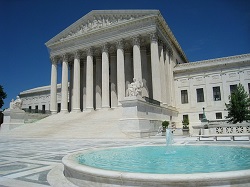 Photo credit: Pixabay.com
Photo credit: Pixabay.com
I’ve been meaning for some weeks now to parse out the whole Supreme Court issue, as this one question is for many people the deciding straw on the camel’s back that forces them to vote for Donald Trump. As Trump himself said in a recent speech, people who don’t like him “have to” vote for him anyway. Why? Supreme Court Justices. The common refrain is that whoever becomes President would be able to appoint at least three judges and possibly four or even more, thus changing the makeup of the Supreme Court for a generation to come. So, even if you fear and despise Donald Trump, you have to save the US Constitution by voting for him, goes the reasoning. I listened to part of a podcast just this morning hosted by the conservative talk-show radio host Hugh Hewitt talking to a high-minded conservative scholar who was spouting this very rhetoric. Dr. Larry Arnn, president of Hillsdale College, was being very critical of NeverTrumpers who say, well, you can’t trust Trump to do what he says (a view amply justified just this week by Trump’s shifts/backpedaling/”softening” on his whole ridiculous immigration policies). I don’t get it. Of course you can’t trust him! But even if you knew for sure that Donald Trump would, if elected, appoint solid-gold, dyed-in-the-wool originalist justices (not “judges,” as he keeps calling them), you still would have no assurance that he would really get to put those people on the Court. Here’s why:
Right now the three oldest justices are Ruth Bader Ginsburg (83) and Stephen Breyer (78), both Bill Clinton nominees who are reliably liberal, and Anthony Kennedy (80), a Reagan nominee and often seen as a swing vote. So the first two are squarely in the liberal camp and Kennedy is variable. I can guarantee that if there were to be a Trump presidency Ginsburg and Breyer would be wheeled into the Supreme Court building on life support rather than retire and give DT a chance to replace them. But, as my husband says, “You can control the day of your retirement, but not the day of your death,” so it’s perfectly possible that one or more of them may die in office during Trump’s term, but, speaking as someone who has an 83-year-old father-in-law who is still hale and hearty, heavily involved in all sorts of activities, I’d say that the death of any of these three during a Trump first term is far from inevitable. Ginsburg has signaled, by the way, that she has no intention of retiring any time soon, as she has hired her law clerks for the coming year.Then we have the left-behind-at-the-altar Merrick Garland, nominated by President Obama to replace Antonin Scalia and held in limbo ever since. The Republican Senate has given various nonsensical reasons for refusing to hold hearings on him,
as outlined in this article by George Will back in March. My son, who seems to have a fair amount of political savvy, says that the lame-duck Senate will go ahead and confirm the lame-duck Obama nominee after Nov. 8. It will be interesting to see if he’s right. Let’s assume that he is and that the Court has its full complement after the new President takes office.
Here’s how various political combinations would almost certainly play out:
1. A Trump Presidency and a Republican Senate.
If the past spinelessness of most Republicans re Trump is any indication, the Senate would confirm Trump nominees, should any vacancies occur during his first two years. Note the “two years.” A Trump presidency would be such a disaster that a tremendous backlash would occur in the 2018 off-year elections, almost certainly resulting in a Democratic majority in Congress. I have postulated that Trump would inevitably do something impeachable during his first two years anyway. So a Trump presidency even with Republican support would result in perhaps one nominee. Trump has given assurances that he’d appoint conservative justices, so let’s take him at his word and assume that he’d actually do that. In reality, it probably won’t matter. If someone doesn’t die or retire during Trump’s first two years, he will have no chance to nominate anyone. And the damage he’ll inflict on the Republican Party and conservatism in general will last for years.
2. A Trump Presidency and a Democratic Senate.
I don’t see any way of this happening, but it’s pretty obvious that no appointments would be confirmed under this scenario unless Trump nominated some kind of left-center candidate, which I wouldn’t put past him.
3. A Clinton Presidency and a Democratic Senate.
This is the scenario that keeps conservatives awake at night. But in reality the same parameters would apply as in #1 above. If the Republicans lose their Senate majority it will certainly be only by one or two, and they would probably be able to regain their majority in 2018 since they won’t have the specter of Donald Trump hanging over them. So, again, unless there’s a vacancy during 2017-2018 Clinton will have to work with a Republican Senate to get nominees approved.
4. A Clinton Presidency and a Republican Senate.
This is the best-case scenario in a worst-case election year. If the Republican Party can pull itself together and nominate someone decent and electable in 2020, the damage can be far less than that caused by scenario #1 above.
So let’s all quit clutching our pearls and reclining on the fainting couch as we moan about how a Clinton Presidency could result in 3-4 SCOTUS liberal nominees. In reality, if we do our jobs, we can hold Clinton to one term, keep Trump out of the White House, minimize the Supreme Court’s shift to the left, and have a chance of rebuilding the GOP.
 Photo credit: Pixabay.com
Photo credit: Pixabay.com
